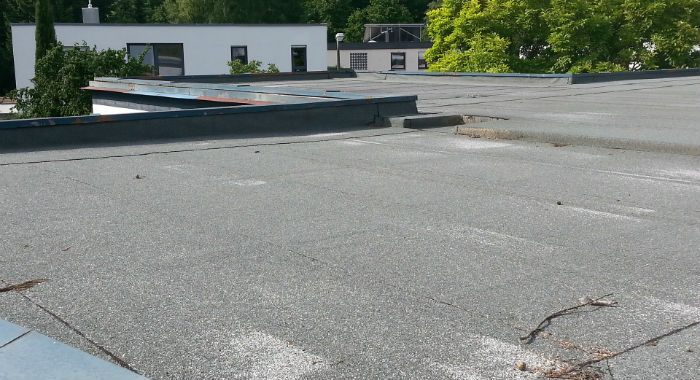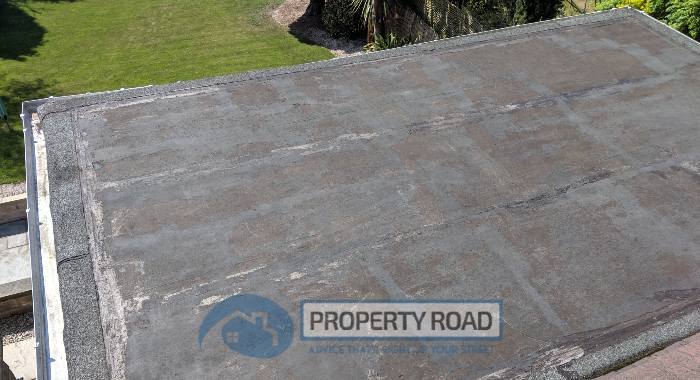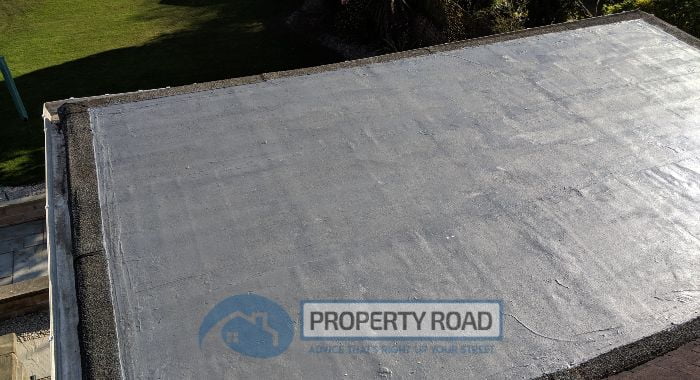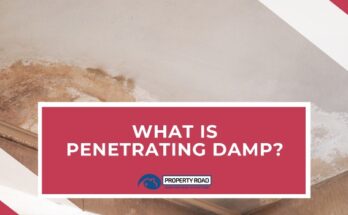For those homeowners who want to know how to maintain a flat roof, the advice is straightforward though there will be potential worries over whether you should buy a house with a flat roof in the first place.
Lots of homebuyers will be reluctant to buy a property that either has a flat roof or has a garage or extension with one because of the maintenance issues.
However, we’ve had a flat roof extension on each of the properties we’ve owned and lived in. We’ve found that as long as it has been properly maintained, you shouldn’t be reluctant or nervous about buying the property.
Of course, it’s important to ask the home seller whether they have maintained it effectively and a full survey will highlight any potential issues – this survey could be invaluable if the surveyor raises any potentially expensive issues.
Why do properties have flat roofs?
Along with putting flat roofs on garages and extensions, there may be other reasons why one has had to be constructed since planning regulations may restrict a pitched roof if it will obstruct a neighbour’s view or light, for example.
Also, a property extension may have to use a flat roof if it butts up to the building itself. In some properties, old asbestos coverings have been replaced with modern flat ones.
Insuring a property that has a flat roof
How easy you’ll find it to insure a property with a flat roof depends on how much of your roof is flat as a percentage of the total roof.
Those with close to 100% flat roofs may find insurance harder to find and certainly more expensive. Whereas those with a percentage of flat roof will typically find it only has a small impact on their insurance, if at all.
The properties we have lived in have had varying amounts of flat roof percentages, from around 20% up to 50% flat roof and we’ve never had any issues getting home insurance. Sure, we might have paid slightly more on our premium, but it wasn’t much extra.
Common problems for a flat roof

So, what are the common problems for a flat roof?
Lifespan
The big worry about a flat roof is they may not be correctly maintained and have a short lifespan.
The lifespan will depend on the materials being used with asphalt and felt-based coverings being less durable when compared to modern materials such as EPDM.
We’ve had flat roofs that were last done 10-15 years ago that had no issues at all. Equally, we’ve had a flat roof that was only 10 years old that we had to have completely replaced.
Much depends on how well they’ve been installed and the materials used.
Problems
Felt flat roofs are prone to splitting, ponding and blistering.
Splitting occurs when it has not been maintained properly or it has been damaged, for example, with someone walking on it. The splitting is caused by pressure, stress, poor workmanship and thawing.
Ponding is an issue when there are standing pools of water that do not dry out or drain away. Sometimes, you may need a pump that will work automatically in problem areas or look to fit drains or carry out repair work to prevent ponding issues.
Blistering occurs when the air becomes trapped between the felt layers. As this air warms up, it can lead to a puncture or blister appearance that may then split. Should this blister occur on a join then water is able to pass through the roof. Blisters should be fixed professionally, so the seal is maintained.
We’ve found the coating on the flat roof is very important, as is the orientation. For example, we had a south facing flat roof that got the sun all day, but because it had a coating of stone chippings on the top, the sun didn’t do any damage whatsoever.
However, we also had a south-facing flat roof in another property that didn’t have any stone chippings on the top and the sun caused the roof to regularly crack and blister. It also made the roof much hotter. So, we found that adding stone chippings can help to avoid some of the common problems of flat roofs.
Protect and maintain flat roofs effectively
While we’ve covered the main problems, there are steps that homeowners can take to protect and maintain their flat roofs effectively. These steps will include:
Maintenance
To prevent your flat roof from being damaged, then maintenance must be carried out on a regular basis, at least every autumn and spring and you will have to carry out an inspection following any heavy weather conditions.
We’ve found that if you have a window overlooking the flat roof, you can often get a good idea of the condition of the roof from inside. However, to be absolutely sure, it’s best to get up there and have a close look if you feel comfortable doing so.

Hire a specialist
A professional will ensure your flat roof is maintained properly by removing dirt as well as debris, drain sand gutters regularly.
It’s important to appreciate that unless your flat roof has been designed specifically for use as an outdoor area, then it’s probably going to be fragile when someone stands on it.
Any damage caused by walking on it may affect the rain run-off and create punctures and blistering.
That said, we’ve found most flat roofs are pretty durable and able to be walked on without any issue. However, we’d recommend avoiding walking on it in wet weather or when it’s very hot as that can cause issues.
Maintenance also extends to areas around the covering, so you will need to cut back overhanging branches to avoid damage and blockage from fallen leaves.
Bad weather
As mentioned earlier, you will have to check for any damage after poor weather, particularly after snow and ensure it is cleared away carefully. Snow can cause significant damage and if water or snow freezes, there when it thaws it’s liable to split the surface.
However, take care when clearly anything from a flat roof as the tools you use to do the clearing can easily damage the roof coating.
Check the ceiling
Maintaining a flat roof properly is not just about inspecting the exterior and you should check the ceiling regularly for any stains that may be caused by water damage.
If you do spot water stains, then you need to act quickly to prevent more damage occurring. Remember that if an area is damp for any length of time, it can cause problems with rot and other timber issues.
If you get into the realms of needing to replace the structure of a flat roof, it’s much more expensive than simply replacing the covering!
Questions about flat roof problems
There may be other questions about flat roof problems that may not have been covered and here we will explain more:
How long do flat roofs last?
Flat roofs can have a long lifespan, but they need to be correctly maintained to do so and they tend to be made from felt, asphalt, GRP fiberglass or EPDM rubber proofing.
A flat roof will usually have a warranty of between 10 and 20 years, but if they are properly installed by professionals and then maintained effectively they can last for 25 years. If it is made with EPDM then the rubber has a life expectancy of up to 50 years, and in some cases can last longer.
How often should you seal a flat roof?

Regular maintenance will be key to ensure it does not leak and will last. You could hire professionals but it is also possible to buy flat roof coat seal from DIY stores to do this work yourself. It will need repairing when there is an issue and resealing.
How often you’ll need to seal a flat roof depends on a number of factors including how exposed to the elements it is, whether it is south facing, and what type of sealant you used previously. Typically most should only need resealing every 5 years or so.
This was a job we had to do in one of our properties shortly after buying it. The flat roof was visible from the bedroom window and every time I looked out I could see the existing coating peeling away.
The roof was south facing and got so hot in summer you could almost fry an egg on it! However, that constant heating up and cooling down is what was causing the surface to deteriorate. Though we didn’t have any visible problems inside, we knew it was only matter of time unless we sealed it.
So, we bought some roof sealant and got a pair of ladders out to do a DIY seal repair. We started by hosing down the roof and scrubbing it clean. This helped remove any loose coating to ensure the new paint had a solid, clean surface to stick to.

Then, we simply painted the seal paint on like you would a normal paint (we used a paintbrush). It took a little while as the paint was so thick and you have to make sure the last bit you paint is next to your ladders otherwise you’ll be stuck!
However, it was a very straightforward job and the roof looked much better for it. We lived in the house another 3 years and when we moved out the coating we applied looked almost as good as new – so if you do it properly, you shouldn’t have to do it too often.
The only things we’d suggest are not to try and do it when it’s hot (we almost baked!) and to add a coating of small stone chippings too. This will help the roof last even longer.
Does moss damage a flat roof?

The short answer is yes, moss can damage a flat roof. Indeed, any unwanted vegetation or growth will highlight that water is being held on the roof to enable moss to grow and it will, ultimately, lead to leaks.
You also need to appreciate that moss will increase the weight and could lead to sagging joists and split the covering.
Another issue with moss is that during winter it will absorb water which then freezes. If there are any imperfections in your roof, this expansion can cause splits, cracks or other damage to occur.
However, it’s also worth keeping in mind that a small amount of moss is unlikely to cause major issues in the short term. But, it’s not worth the risk of letting it build up over the longer term.
Can flat roofs be repaired?
Yes. There may be a range of issues from the simple replacement of the felt, though, if there are problems with the joint joists or membrane, then it may lead to a bigger job or a complete flat roof replacement.
On one of our flat roofs, the only real issues were around the edges. This meant that we didn’t have to spend on a complete roof replacement but instead could just get the edges replaced. While there was still a reasonable amount of cost for this, it was a lot cheaper than a full roof replacement!
Flat roof maintenance costs
It costs nothing to carry out regular maintenance, such as cleaning and removing debris from gutters. The price of sealant starts at £5 for a small tin if you want to do the work yourself.
As mentioned earlier, when we put a new coat of sealant on our flat roof we found it to be a relatively easy job, not too different to any other type of painting. However, it does require some confidence with ladders and working at height so it might not be a DIY job for everyone!
For those who need a new flat roof and use the current structure, then the cost will range from £800 – £1,200, this is for the price of a typical single garage size using modern products including rubber EPBM.
Flat roof gravel
Some flat roofs will have a gravel coating which plays two important roles. The first is to weigh down the covering surface and the second role is to protect it from sun damage.
Traditionally, a flat roof will be made watertight and the gravel will keep it weatherproof. You could use professionals or carry out the repair yourself using tar and gravel repair kits from a DIY shop.
In our experience, flat roof gravel or stone chippings do a great job at protecting your roof, especially if it is of south-facing orientation. Without it, the sun just bakes the roof and causing it to degrade faster. We also found that with gravel, the roof didn’t heat up as quickly which kept indoors a little cooler during summer.
Flat roof protection
The flat roof will need surface protection to help protect it from the sun’s rays but also from the thermal movement since the roof will expand in hot weather and also differential movement – that’s when it is warmer than the structure below it.
Under building regulations, there will be a need for fire protection and this is specified to help control the spread of any flames.
If you are replacing the flat roof, it would be a good idea to look at installing or upgrading the insulation within it too. This will help you save money on energy bills since flat roofs are typically less energy efficient than pitched roofs as there’s less space to insulate well.
Flat roof shingles
As with gravel, flat roof shingles, sometimes known as pea shingle flat roofs, provide a loading coat and help to protect the surface from sun damage.
The shingle needs to be properly bonded to the surface material and it cannot be scattered across the roof. Done properly, a shingles’ prepared flat roof will provide a surface that will last for many years – when it has been badly done and shingle is loose it’s a sign of poor quality work.
Repair work on a flat roof
Along with carrying out any repair work on a flat roof yourself, you could hire a professional, but you should:
- Ensure that they specialise in this particular type of construction
- Have them give a fixed cost quote
- Check they have insurance for carrying out the work
- Have a written estimate of how long any repair work will take
- Ensure that any work carried out is done under a warranty or guarantee.
Essentially, if you fall in love with a property but are worried about the problems that may arise from having to maintain a flat roof, then it’s crucial that you have a proper survey done to ensure that it has been cared for properly. Then make sure that you carry out maintenance checks at least twice a year and undertake any repairs that need doing immediately.
Further information:
Confederation of Roofing Contractors
National Federation of Roofing Contractor




